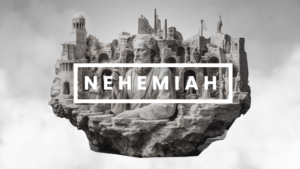In Genesis 6-9, we encounter a defining moment in human history: the story of Noah and the flood. This ancient narrative reveals more than just a catastrophic event—it highlights humanity’s urgent need for salvation, God’s righteous judgment, and His profound mercy. As the floodwaters rise, God’s justice against sin is transparent, but so is His offer of grace through the ark, a symbol of His provision for escape. Ultimately, the story of Noah serves as a powerful foreshadowing of Jesus Christ, the “greater Noah,” who fulfills God’s covenant and offers eternal salvation to all who believe. Through faith in Christ, just as Noah was spared from destruction, we are rescued from the ultimate judgment. This story calls us to recognize the weight of sin, trust in God’s redemptive plan, and walk in faithful obedience to His Word.
1. Humanity’s Desperate Need for Salvation (Genesis 6)
Genesis 6 paints a grim picture of a world engulfed in sin. Humanity’s corruption has reached such depths that God is grieved over His creation (Gen. 6:6). The descendants of Cain, exemplified by Lamech, have spread violence and wickedness. In contrast, even the descendants of Seth, though they “called upon the name of the Lord” (Gen. 4:26), cannot escape the consequences of sin. Despite some righteous figures like Enoch, the reality of death and judgment looms over them all.
The Bible reveals that the sons of God (interpreted by some as the descendants of Seth) intermarried with the daughters of men (possibly the descendants of Cain), further deepening the corruption on the earth. Regardless of the specific interpretation, the focus is on the depth of mankind’s depravity. God’s response is sorrowful, and He announces His decision to bring a flood to cleanse the earth (Gen. 6:7).
Yet, amidst this dark backdrop, Noah stands out. Noah, a righteous man in a corrupt world, has faith in God’s warning and provision, which sets him apart. His obedience to God’s command to build the ark symbolizes his family’s salvation. Humanity is offered a glimpse of hope through Noah’s faith and God’s mercy in the midst of impending judgment.
2. Tho Sin is Great… God’s Mercy is Greater (Genesis 7)
The floodwaters in Genesis 7 are a stark reminder of God’s justice and holiness. The earth is flooded for 40 days and 40 nights, and all living creatures that do not enter the ark perish. This flood represents God’s justice against a world that has chosen sin over obedience. It is a harsh yet necessary act, for sin cannot be allowed to go unpunished. As difficult as it is to grasp, the flood demonstrated God’s righteousness and His right to judge a world that rejected Him.
However, amid this destruction, there is mercy. Noah and his family and the animals are saved through the ark. Just as Noah trusted in God’s plan, so must we trust in the vehicle of salvation provided by God. Just as the ark was the only means of survival, Jesus Christ is the only way to escape the judgment that awaits the sinful world (John 14:6). The ark foreshadows the ultimate salvation found in Christ.
3. Trust in a New Covenant and a Greater Savior (Genesis 8-9)
After the floodwaters recede, Noah and his family leave the ark and begin repopulating the earth. In Genesis 9, God establishes a covenant with Noah, promising that He will never again destroy the world with a flood. The rainbow, a sign of this covenant, symbolizes peace after the storm of judgment. It is a beautiful reminder of God’s mercy, yet the rainbow also points to a more incredible promise—one fulfilled in Christ.
This covenant with Noah is not a partnership between God and humanity but a unilateral promise made by God to Himself. It represents grace, unearned favor, as God ensures that humanity’s salvation will not be thwarted. But as we see in Noah’s fall into sin (Gen. 9:21-23), even the righteous need a greater Savior. Noah, though virtuous, falls victim to sin, highlighting the need for someone who will be the ultimate fulfillment of God’s promises.
Of course, the greater Noah is Jesus Christ, who not only provides salvation from sin but also serves as the ultimate example of perfect obedience. Through His death on the cross and resurrection, He became the means of salvation for all who believe. God’s covenant with Noah points to the new covenant, which is entirely based on God’s grace and not human effort.
Conclusion
In Noah’s day, the people had the opportunity to repent and enter the ark, but most ignored God’s warnings. Today, the world continues to ignore God’s call for salvation. Jesus Himself used the days of Noah as a warning for His return, when the final judgment will come (Matt. 24:37-39). Just as Noah’s generation was caught unprepared for the flood, so too will many be unprepared for the final judgment if they do not heed the call of salvation in Jesus Christ.
The story of Noah is more than just an ancient flood narrative; it is a vivid illustration of God’s justice and mercy and the ultimate need for salvation. The flood is a clear warning of the consequences of sin, but it also points to the hope of salvation found in God’s provision. Like Noah, we must trust in the vehicle of salvation provided by God, which today is Jesus Christ. Just as the ark was the only means of escaping the flood, so is Christ the only way to escape the judgment that awaits all who reject God.
As we reflect on this story, may we remember the severity of sin, the certainty of judgment, and the hope of mercy through faith in Jesus Christ. Let us not ignore God’s warning as the people in Noah’s day did, but instead, trust in His provision and live in faithful obedience to His Word.



